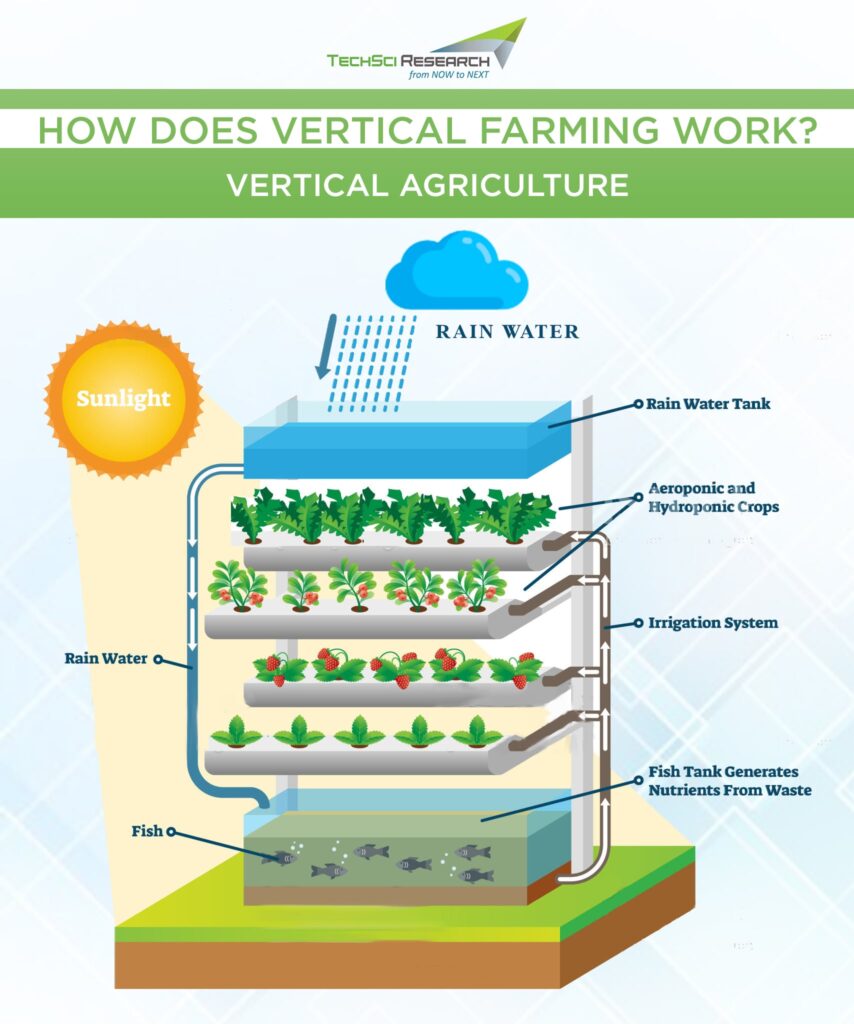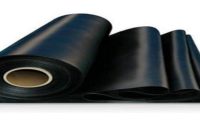Is Vertical Farming the Future of Urban Agriculture?
More than half the world’s population (approximately 4 billion) live in urban areas. As people continue to migrate from rural to urban areas, the global urban population is anticipated to reach around 7 billion people by 2050. The growing urbanization activities could pose a threat to food security since they are likely to reduce the availability of valuable croplands, which are necessary to produce an adequate amount of fresh food for the rising population. According to a study, the global urban expansion would result in approximately 1.8-2.4% loss of global croplands and a 3-4% reduction in crop production by 2030. Besides, changing climatic conditions could put a strain on Earth’s resources, creating a serious demand-supply chain issue. Therefore, sustainable development and growth of the urban population require a great need for innovative farming methods to meet the demand for more food and more land to grow food. Vertical farms are at the forefront of the controlled environment agriculture segment and rapidly take over traditional farming methods for producing eco-friendly products in metropolitan areas.

Vertical farming (VF) or high-rise farming essentially means indoor farming in vertical greenhouses with regulated growing conditions, offering a favorable environment for crops to thrive, regardless of the weather conditions outside. This kind of agriculture practice has the potential to produce food year-round and thus maintain a steady flow of products for consumers as well as ensure consistent income for growers. Besides, vertical farming provides an array of advantages such as urban water recycling, fewer farm inputs, low crop failure risks, restored farmland, energy conservation, reduced soil erosion and air pollution, urban beautification, and ecological sustainability. Due to the significant benefits of vertical farming over traditional methods of agriculture, many countries have started implementing the innovative farming system on a large scale.
How Does Vertical Farms Work?
In vertical farming setup, plants are arranged in layers that can reach several stories high. For this purpose, multi-story buildings (also known as farm scrapers) are utilized to produce vegetables in a space-saving manner. Modern technologies like artificial intelligence, machine learning, and Internet of Things are utilized to provide adequate conditions for crops and every parameter that affects the growth of crops is closely monitored. Workers take preventive measures to eliminate the risk of pest infestations that could damage crops. Smart sensors monitor technical variables such as temperature, light, carbon dioxide, oxygen, humidity, precipitation, nutrient concentration, pest control, and irrigation whereas advanced imaging technologies measure plant growth, temperature, and other factors. All these modern technologies are a part of controlled environment systems (CES), which have proven beneficial to grow leafy greens, herbs, microgreens, and vegetables like pepper, tomatoes, etc. Some of the essential components of controlled environment systems include:

- Dosing systems
Dosing systems are utilized in vertical farms to provide optimal nutrients to the plants and monitor nutrient solutions. Automated dosing systems are connected to peristaltic pumps that suck the required dose of nutrients and dispense them into the reservoir, which further supplies a precise amount of nutrients to each plant. Probes placed inside the reservoir continuously provide information about pH and EC levels, nutrient concentration, water temperature, etc. More control over nutrient solution with automated dosing reduces the risk of plant shock or stunted growth.
- Sterilizing Systems
The crops grown in vertical farms need to comply with international food safety regulations. Hence, adopting rigorous sterilization and disinfection strategies in indoor farming is necessary to ensure the production of pesticide-free crops throughout the year. Common sterilization methods include chemical disinfection, UV sterilization, and ozone sanitation. Chemical disinfection involves sterilizing floors, transporting equipment, and other tools with hypochlorite and hydrogen peroxide. UV sterilization is a chemical-free method involving UV emitting light to destroy micro-organisms invisible to the naked eyes, such as fungi, viruses, and other pathogens. Ozone sanitation is performed to clean air in indoor farms, killing fungi and other microorganisms.
- Lighting
Artificial light used in vertical farming is the crop’s sole source of illumination, so the grower needs to do a great deal of research to control the light, intensity, and duration to ensure plant growth and generate a good yield. Every stage of plant growth requires different lighting; thus, many companies provide light formulations to vertical farmers to increase biomass production and enhance flavor. Generally, three kinds of lights are used for vertical farming such as LED lights, high-pressure sodium lights, and fluorescent grow lights. LED lamps are one of the most common choices since they generate less heat than high-pressure sodium (HPS) grow lights, lasts long, and conserve energy. HPS grow light promotes flowering and fruiting but can slow down plant growth during the early stage of development and affect output. Also, HPS lights emit a lot of heat since they contain mercury, which can prove to be hazardous for health. Fluorescent lights are highly efficient since they produce less heat and are specially designed for indoor farming.
- Air Control
Vertical farmers need to maintain the ideal CO2 concentration (1000 parts per million) in the indoor farming set up to promote rapid plant growth and increase plant productivity. Some common type of CO2 enrichment techniques involves CO2 gassing, compressed CO2, and misting aqueous CO2 through delivery solutions. CO2 gassing is a conventional method of producing carbon dioxide gas by burning propane or natural gas into the plant growing area. Another method is to transform compressed CO2 into gaseous form and inject it into the growing chamber for a certain time frame. CO2 delivery systems are one of the cost-effective methods of infusing gas directly as microdroplets into the plant’s leaves via an overhead misting system. Besides, vertical farms must maintain proper airflow, reducing the build-up of heat and humidity in the growing area to reduce the risk of infection. Generally, airflow transducers are used and located at the farm’s entrance and exit points to assess air velocity continuously and transmit data to the terminal. Additionally, dehumidifiers and dehumidification systems are utilized to eliminate excess moisture and maintain optimal humidity in the growing area.

Types of Vertical Farming
- Hydroponics
Hydroponics, one of the predominant growing systems used in vertical farming, involves submerging plant roots into nutrient solutions devoid of soil. Instead of soil, other materials such as gravel and sand are used to allow better absorption of macronutrients and support plants’ roots. Hydroponics gardens in urban settings serve as large heat sinks that radiate heat and maintain the ambient temperature while improving the air quality inside the house. Some other advantages of hydroponic farming include increasing crop yield while decreasing the amount of water consumption by plants. This kind of farming method is beneficial for regions with arid climates or low soil quality, such as sub-Saharan Africa, as it can provide fresh farm products to local areas and thus combat hunger. Hydroponic farms utilize 90% less water compared to traditional farms and allow farmers to grow 3 to 10 times more crops in the same amount of space as conventional farms, depending on the layout. Hydroponic farming is already being integrated into current food networks by leading food retail giants. For instance, in 2019, British online supermarket Ocado signed MoU to partner with top vertical farm industry players, Priva and 80-Acres for supplying fresh and local ingredients to its customers.
- Aquaponics
Aquaponics combines aquaculture and hydroponics, wherein the nutrient-rich waste produced by fishes serves as a feed source to the plants present in vertical farms. The wastewater is then purified and recycled into the fish tank, enabling relatively cheap and easy harvesting of plants. Fruits and vegetables produced in aquaponic systems decrease root diseases in crops and ensure a good source of fresh fish. Some of the advantages of aquaponics include lesser resources, environment-friendly, space-saving, easy to maintain, affordable, and requiring less labor. However, only selected kinds of crops can be grown with aquaponic farming. From small individual to large scale companies are utilizing aquaponics to produce organic foods. For instance, Ouroboros Farms in California and Trader Hill Farm in Florida have the largest aquaponics system farm in the USA.
- Aeroponics
Aeroponic systems developed by the National Aeronautics and Space Administration (NASA) in the 1990s are gaining a lot of traction these days. Aeroponic systems use up less than 90% less water than other vertical farming systems. Besides, plants grown through this kind of agriculture practice are loaded with more minerals and vitamins, which make them nutritious.
Conclusion
Vertical farms have the potential to change the world’s agriculture landscape and shape the USD5 trillion agriculture industry. The indoor farming technology is anticipated to reach USD40.25 billion by 2022 as crops will be grown in three dimensions rather than two, that too, all year round and independent of external weather conditions. One of the major challenges with vertical farming is the high cost of setting up and installing modern technologies. However, new indoor farming companies are coming up with high-tech glass-clad greenhouses that primarily rely on natural sunlight, which eliminates the use of artificial lights and thus conserves energy. Although vertical farming technology is in a nascent stage, more innovations in this direction can lead to its increased adoption and more commercial availability.



